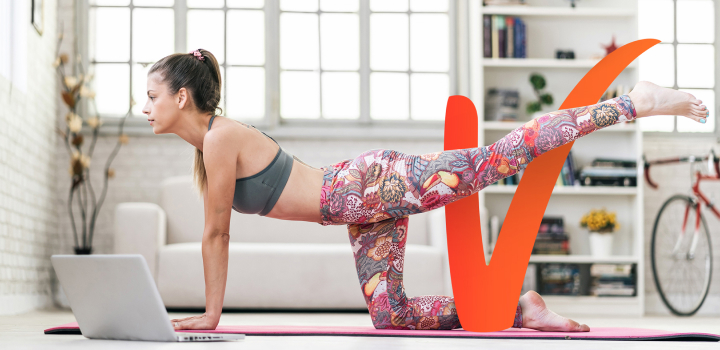
Do you miss running like we do? There’s a silver lining to being at home. Use this time to start a habit of regular strength training that will improve your coordination and make you a more efficient runner.
Strength training can make all the difference to your running and get you ready for a peak performance at your next training run or race event. Vitality biokineticist Mari Leach recommends small and regular efforts to build your core and overall body strength.
Speed and stability
- Weight exercises strengthen your muscles, the joints in-between and the connective tissue that surrounds these joints. All this helps to stabilise your movements and prevent injuries.
- Strengthening your supporting muscle groups will help to stabilise and tone your entire body. This is important because imbalances in different muscle groups cause strain on weaker links in your kinetic chain (for example, some runners are prone to hamstring injuries from having tighter quads than hamstrings).
- Cross training will improve your reflexes, overall neuromuscular coordination and power, making you faster and more agile.
Focus areas for runners
Whether you recently took up jogging or whether you’re an experienced runner, if you want to improve your ability and avoid injury, focus on these key areas:
- Core: Having a stronger core will improve your running posture, stride and even your breathing, as your lungs have more space to expand when your chest is up and your shoulders are relaxed.
To strengthen your core: Try front, side and reverse planks, back extensions, Supermans, V-sits, reverse leg raises and side-to-side leg rotations. - Glutes: When it comes to running, glutes are your powerhouses. Strong extensor muscles will propel you forward and increase your speed. Glute muscles can get weak from too much sitting, so it’s especially important to fit in isolated glute exercises while you’re more sedentary at home.
To strengthen your glutes: Try single-leg split squats, single-leg deadlifts and plyometric jumps, such as lunge jumps, jump squats and box jumps. - Hips and pelvis: It’s important to keep your pelvis level when you run, and not tilt, dip or rotate them too much. If one side of your pelvis drops as you run, it could be a sign of a weaker gluteus medius on the higher side. Extended periods of sitting also shortens and stiffens your hip flexors. Increasing your range of movement will help you better engage and strengthen your extensor muscles, like your hamstrings and your glutes.
To strengthen your hips: Try exercises such as standing hip hikes and side planks with a leg raise.
You don’t need big weights, machines or equipment for strength training, Mari points out. “While props can widen your repertoire, simple bodyweight exercises are a good place to start building a solid foundation. You can also incorporate plyometric exercises to improve the elasticity of your connective tissue and fire up those fast-twitch muscle fibres.”
“Just make sure you start slowly and gradually increase the exercise intensity and volume. Remember that you need enough recovery time between sessions to allow the tissue to adapt and to avoid overtraining,” she adds.
By setting regular sessions aside exclusively for strength training, you’ll see your running performance improve in leaps and bounds. So ready yourself to hit the road by pulling, pushing and lifting more today.
Run across South Africa with the new virtual Vitality Run Series
The Vitality Run Series is back by popular demand – now in a new virtual format that anyone can complete in the comfort and safety of their homes.
This May, you can run across four epic destinations in South Africa and earn hundreds of Vitality points as you go. The races will take place in the Western Cape, Gauteng, KwaZulu-Natal and Kruger National Park. Vitality members will earn 300 fitness points for the 5km or 10km run or walk. Find out more here.
Looking for more Fitspiration?
Check out the Vitality Home-Workout Channel – a daily schedule of FREE High Intensity Interval Training workouts, yoga, fitness challenges and more for the whole family. You can get 50 Vitality points for every 30+ minute workout when you are logged into your Discovery account. Choose your next workout here.
Disclaimer: We recommend that you obtain medical clearance before starting to exercise. There are risks associated with exercising which can result in serious injury and even death. By participating in the abovementioned exercises, you accept full responsibility for such risks. Discovery Vitality (Pty) Ltd and its affiliates shall not be liable for any injury, loss or damage whatsoever and howsoever arising from any exercise advice given, including loss or damage to person or property.

Introducing Vitality at Home
Vitality brings you Vitality at Home so you can continue to achieve your fitness and nutrition goals.
We're pulling out all the stops to help you stay healthy and rewarded during this stay at home period.